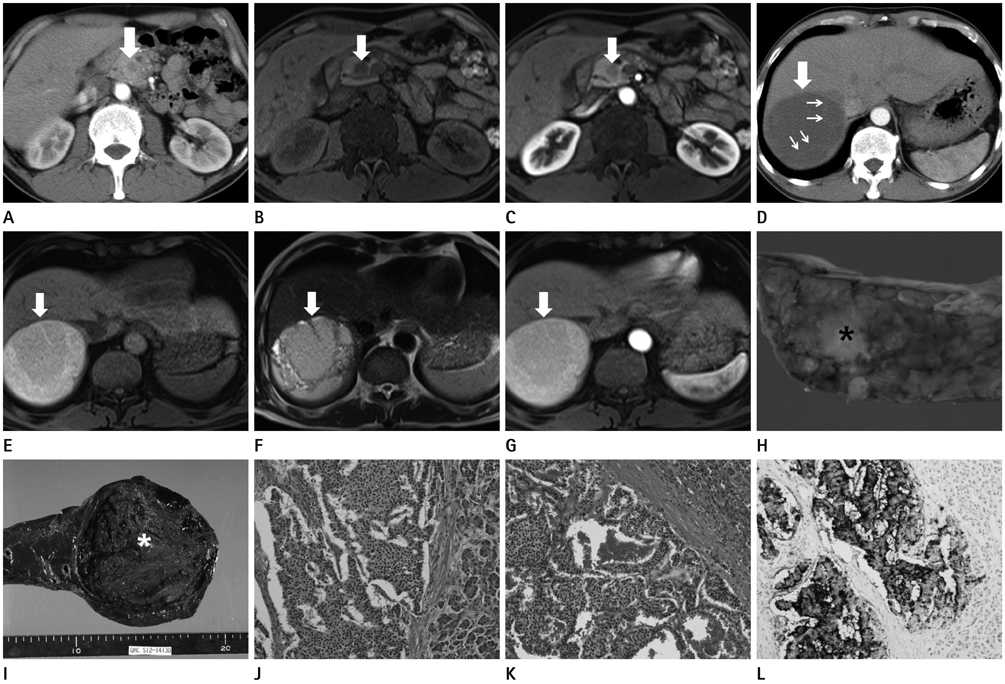J Korean Soc Radiol.
2014 May;70(5):351-354. 10.3348/jksr.2014.70.5.351.
Well-Differentiated Pancreatic Neuroendocrine Tumor with Solitary Hepatic Metastasis Presenting as a Benign Cystic Mass: A Case Report
- Affiliations
-
- 1Department of Radiology, Gachon University Gil Hospital, Incheon, Korea. sjchoi@gilhospital.com
- KMID: 1941780
- DOI: http://doi.org/10.3348/jksr.2014.70.5.351
Abstract
- Pancreatic neuroendocrine tumors and their hepatic metastases have an inconsistent appearance with only a small percentage of lesions appearing as cystic masses in computed tomography (CT) and magnetic resonance imaging (MRI). Therefore, they can be mistaken as benign or infectious lesions, which can lead to a false diagnosis with delayed or inadequate treatment. We reported a patient with upper abdominal pain that lasted for several months, caused by a huge cystic neuroendocrine carcinoma of the liver. This was mistakenly interpreted as a complicated or hydatid cyst, and the findings in the CT and MRI was presented.
MeSH Terms
Figure
Reference
-
1. Gumbs AA, Moore PS, Falconi M, Bassi C, Beghelli S, Modlin I, et al. Review of the clinical, histological, and molecular aspects of pancreatic endocrine neoplasms. J Surg Oncol. 2002; 81:45–53. discussion 54.2. Franko J, Feng W, Yip L, Genovese E, Moser AJ. Non-functional neuroendocrine carcinoma of the pancreas: incidence, tumor biology, and outcomes in 2,158 patients. J Gastrointest Surg. 2010; 14:541–548.3. Bosman FT, Cameiro F, Hruban RH. WHO Classification of Tumours of the Digestive System. 4th ed. Lyon: International Agency for Research on Cancer (IARC);2010. p. 13–14. p. 64–68.4. O'Toole D, Ruszniewski P. Chemoembolization and other ablative therapies for liver metastases of gastrointestinal endocrine tumours. Best Pract Res Clin Gastroenterol. 2005; 19:585–594.5. Oberg K, Eriksson B. Endocrine tumours of the pancreas. Best Pract Res Clin Gastroenterol. 2005; 19:753–781.6. Sarmiento JM, Farnell MB, Que FG, Nagorney DM. Pancreaticoduodenectomy for islet cell tumors of the head of the pancreas: long-term survival analysis. World J Surg. 2002; 26:1267–1271.7. Debray MP, Geoffroy O, Laissy JP, Lebtahi R, Silbermann-Hoffman O, Henry-Feugeas MC, et al. Imaging appearances of metastases from neuroendocrine tumours of the pancreas. Br J Radiol. 2001; 74:1065–1070.8. Krohn M, Grieser C, Weichert W, Pascher A, Denecke T. Well-differentiated neuroendocrine carcinoma mimicking an echinococcus cyst of the liver in CT-MRI findings with hepatocyte specific contrast material. J Gastrointestin Liver Dis. 2011; 20:439–442.9. Musunuru S, Chen H, Rajpal S, Stephani N, McDermott JC, Holen K, et al. Metastatic neuroendocrine hepatic tumors: resection improves survival. Arch Surg. 2006; 141:1000–1004. discussion 1005.
- Full Text Links
- Actions
-
Cited
- CITED
-
- Close
- Share
- Similar articles
-
- Primary Gastric Neuroendocrine Tumor with Hepatic Metastasis
- Pancreatic Collision Tumor of Desmoid-Type Fibromatosis and Mucinous Cystic Neoplasm: A Case Report
- Long-term Survival in Patient with Metastatic Pancreatic Neuroendocrine Tumor Treated by Variable Treatment
- Surgical Results of Pancreatic Neuroendocrine Tumors
- Case report of solitary giant hepatic lymphangioma


